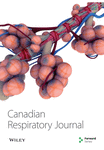Severe Asthma Associated with Myasthenia Gravis
Abstract
Severe asthma constitutes a subgroup of approximately 10% of all asthma cases. Approximately one-half of these individuals have a refractory form of the disease in which atopy and T-helper cell 2-skewed immunological response may not be as closely linked to the disease as in other phenotypes of asthma. This suggests that not all asthma is explained by a T-helper cell 2-skewed immunological response, and that other immunological mechanisms may be important in this category of nonatopic asthma. The authors present a case involving a 55-year-old Caucasian man with nonatopic, adult-onset asthma, nonsteroidal anti-inflammatory drug sensitivity and idiopathic urticaria. This individual presented two years following his initial asthma diagnosis with diplopia and mild ptosis, and was subsequently diagnosed with seropositive myasthenia gravis.




